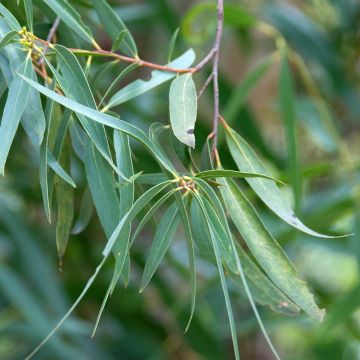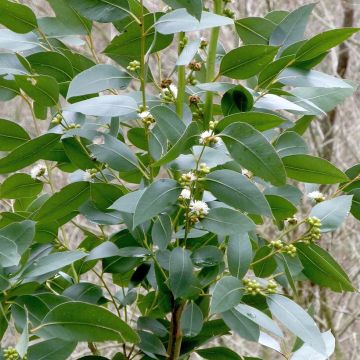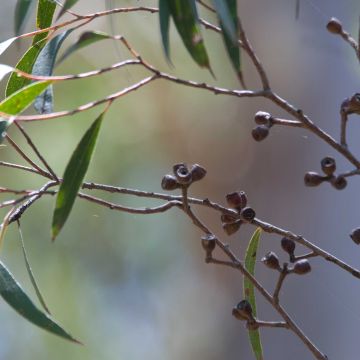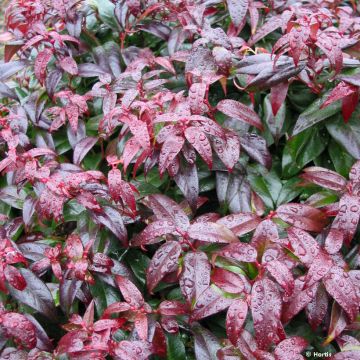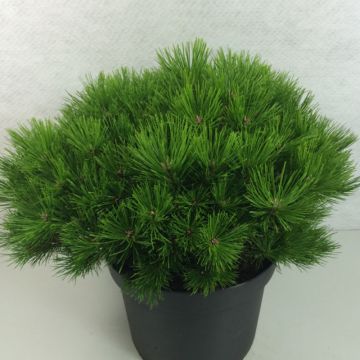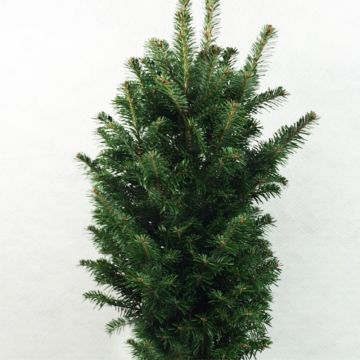

Eucalyptus moorei var. moorei
Eucalyptus moorei var. moorei
Eucalyptus moorei subsp. moorei
Narrow-leaved Sally
This item cannot be shipped to the selected country
Delivery charge from €5.90
More information
Schedule delivery date,
and select date in basket
This plant carries a 24 months recovery warranty
More information
We guarantee the quality of our plants for a full growing cycle, and will replace at our expense any plant that fails to recover under normal climatic and planting conditions.
From €5.90 for pickup delivery and €6.90 for home delivery
Express home delivery from €8.90.
Does this plant fit my garden?
Set up your Plantfit profile →
Description
Eucalyptus moorei var. moorei is a species with moderate growth and low development, rarely exceeding 6 m (19 ft 8 in) in height. This bush mostly forms multiple trunks, which display a beautiful decorative bark in whitish, beige, grey and other colours. It is recognised by its fine and abundant foliage, consisting of small green leaves with shiny reflections, which in the juvenile state take a beautiful slightly bluish hue. It also produces a pretty flowering in white pompoms that can spread over many weeks. An ideal variety for small gardens, easy to acclimate in most regions except those with very cold winters.
Eucalyptus constitute a wide genus of plants, rich in about 800 species, grouping both bushes a few metres high and immense trees, sometimes peaking at more than 90 m (295 ft 4 in) high (E. regnans, E. nitens...). All belong to the Myrtaceae family, richly represented in the tropics and warm temperate climates. Like most species, the Eucalyptus moorei subsp. moorei is native to Australia, where its distribution area is mainly located in the state of New South Wales. It is found in different areas, such as the Blue Mountains west of Sydney, at an altitude varying from 1000 to 1200 m (3280 ft 10 in to 3937 ft), as well as in the Budawang mountain range, further south, towards Canberra, between 600 and 800 m (1968 ft 6 in and 2624 ft 8 in) altitude. These are regions characterised by hot summers and cool or cold winters, without a distinct dry season. This plant grows in often shallow and poor soils, near swampy areas, without having its feet in the water. It actually prefers grounds made up of coarse sands, even if it tolerates short periods of marked humidity.
This species is part of the mallee group, an aboriginal term for several genera, including Eucalyptus, characterised by a height of less than 10 metres (32 feet 10 inches), and a bushy habit starting on several stems from ground level. It thus often forms dense thickets in nature. It develops a lignotuber, an underground formation from which many buds emerge that regenerate branches when the aerial part is destroyed by fire or grazed by animals. This characteristic is interesting for ornamental purposes, as it is possible to prune the bush to limit its development, or to force it to branch out lower.
Eucalyptus moorei var. moorei is one of the two known subspecies (the other being serpentinicola). It forms a bushy shrub reaching 6 to 7 m (19 ft 8 in to 23 ft) in height and about 4.5 m (14 ft 10 in) in width. It sometimes develops a single short trunk, but more often multiple trunks, which is an advantage at the ornamental level, because the bark is very decorative. It is smooth and peels off in shreds that fall at the foot of the plant, it takes on varied colours: white, yellow, grey, beige-brown, green... This shrub is also remarkable because of its graceful, evergreen and aesthetic foliage. Its fineness earns it in Australian English the nickname of "little willow" or "narrow-leaved willow" (narrow-leaved sally), because the resemblance is indeed quite strong with this genus yet far removed from the Myrtaceae… The small juvenile foliage, is made up of opposite and sessile, ovate to elliptical leaves, only 2.8 to 4.5 cm (1.1 to 1.8 in) long and 0.6 to 2.5 cm (0.2 to 1 in) wide. They have a beautiful blue-green colour at first, then gradually turn a shiny green. The adult foliage, slightly larger, is even narrower, the lamina of the leaves measuring up to 9 cm (3.5 in) long and 1.3 cm (0.5 in) wide. Lanceolate to crescent-shaped, petiolate and alternate, also a beautiful shiny green.
Between February and May in Australia, this shrub is adorned with a beautiful white flowering in pompoms. The axillary umbels group together 7 to 15 small flowers without petals, whose white stamens form very visible bouquets. They are followed by small brown fruits that form balls, without any real aesthetic interest.
This species grows in a fairly significant variety of soils, with an acidic, neutral or even moderately alkaline pH. It will grow in moist to temporarily wet, even waterlogged soils, and drier conditions. Resistant to frost down to -10°C (14 °F), it is therefore an easy species to acclimatise in many regions, with the exception of those with really cold winters.
This Eucalyptus shrub, ornamental for its bark, its original foliage, and its white flowering, will find a place in the smallest gardens, thanks to its reduced dimensions and its tolerance to severe pruning. It adopts a natural habit that will integrate well into a natural garden, with a small exotic touch. Plant with it an Asimina triloba Allegheny, the pawpaw with its amazing fruits tasting of mango and banana, and which will also offer you beautiful autumn colours. Its rather large foliage will contrast well with the fineness of your little Eucalyptus. Magnolia tripetala will allow you to create a similar contrast due to its large, bright green leaves.
Report an error about the product description
Eucalyptus moorei var. moorei in pictures


Plant habit
Flowering
Foliage
Botanical data
Eucalyptus
moorei subsp. moorei
Myrtaceae
Narrow-leaved Sally
Australia
Other Eucalyptus
Planting and care
Eucalyptus moorei var. moorei is best planted at the start of autumn in a warm climate, to benefit from the winter rains, or at the start of spring, after the last frosts, in colder areas. It is very tolerant regarding the chemical nature of the soil, accepting soil with acidic, neutral or moderately alkaline pH. It grows in well-drained sandy soils but also accepts heavier, damp clays that take longer to dry out, provided they are not flooded. It is also satisfied with shallow and poor soils, it is a rather accommodating species. Its main requirement is a very sunny exposure and not too hard winter, as it is only moderately hardy, down to about -10°C (14 °F).
Dig a 50 cm (19.7 in) hole in all directions and soak the root ball in a bucket for a quarter of an hour to thoroughly soak it before placing it in the ground. Refill and water abundantly. It will need to be watered regularly during the first year, then occasionally the second. After that, it will prove to be quite resistant to dry spells, even if it will always appreciate a supply of water.
Its growth is moderately fast and it does not require pruning, it will tolerate pruning well after 3 or 4 years of cultivation. In March, you can even cut back near the ground to form a beautiful, densely bushy plant of 2-3 m (6 ft 7 in-9 ft 10 in) high.
Planting period
Intended location
Care
This item has not been reviewed yet - be the first to leave a review about it.
Evergreen shrubs
Haven't found what you were looking for?
Hardiness is the lowest winter temperature a plant can endure without suffering serious damage or even dying. However, hardiness is affected by location (a sheltered area, such as a patio), protection (winter cover) and soil type (hardiness is improved by well-drained soil).

Photo Sharing Terms & Conditions
In order to encourage gardeners to interact and share their experiences, Promesse de fleurs offers various media enabling content to be uploaded onto its Site - in particular via the ‘Photo sharing’ module.
The User agrees to refrain from:
- Posting any content that is illegal, prejudicial, insulting, racist, inciteful to hatred, revisionist, contrary to public decency, that infringes on privacy or on the privacy rights of third parties, in particular the publicity rights of persons and goods, intellectual property rights, or the right to privacy.
- Submitting content on behalf of a third party;
- Impersonate the identity of a third party and/or publish any personal information about a third party;
In general, the User undertakes to refrain from any unethical behaviour.
All Content (in particular text, comments, files, images, photos, videos, creative works, etc.), which may be subject to property or intellectual property rights, image or other private rights, shall remain the property of the User, subject to the limited rights granted by the terms of the licence granted by Promesse de fleurs as stated below. Users are at liberty to publish or not to publish such Content on the Site, notably via the ‘Photo Sharing’ facility, and accept that this Content shall be made public and freely accessible, notably on the Internet.
Users further acknowledge, undertake to have ,and guarantee that they hold all necessary rights and permissions to publish such material on the Site, in particular with regard to the legislation in force pertaining to any privacy, property, intellectual property, image, or contractual rights, or rights of any other nature. By publishing such Content on the Site, Users acknowledge accepting full liability as publishers of the Content within the meaning of the law, and grant Promesse de fleurs, free of charge, an inclusive, worldwide licence for the said Content for the entire duration of its publication, including all reproduction, representation, up/downloading, displaying, performing, transmission, and storage rights.
Users also grant permission for their name to be linked to the Content and accept that this link may not always be made available.
By engaging in posting material, Users consent to their Content becoming automatically accessible on the Internet, in particular on other sites and/or blogs and/or web pages of the Promesse de fleurs site, including in particular social pages and the Promesse de fleurs catalogue.
Users may secure the removal of entrusted content free of charge by issuing a simple request via our contact form.
The flowering period indicated on our website applies to countries and regions located in USDA zone 8 (France, the United Kingdom, Ireland, the Netherlands, etc.)
It will vary according to where you live:
- In zones 9 to 10 (Italy, Spain, Greece, etc.), flowering will occur about 2 to 4 weeks earlier.
- In zones 6 to 7 (Germany, Poland, Slovenia, and lower mountainous regions), flowering will be delayed by 2 to 3 weeks.
- In zone 5 (Central Europe, Scandinavia), blooming will be delayed by 3 to 5 weeks.
In temperate climates, pruning of spring-flowering shrubs (forsythia, spireas, etc.) should be done just after flowering.
Pruning of summer-flowering shrubs (Indian Lilac, Perovskia, etc.) can be done in winter or spring.
In cold regions as well as with frost-sensitive plants, avoid pruning too early when severe frosts may still occur.
The planting period indicated on our website applies to countries and regions located in USDA zone 8 (France, United Kingdom, Ireland, Netherlands).
It will vary according to where you live:
- In Mediterranean zones (Marseille, Madrid, Milan, etc.), autumn and winter are the best planting periods.
- In continental zones (Strasbourg, Munich, Vienna, etc.), delay planting by 2 to 3 weeks in spring and bring it forward by 2 to 4 weeks in autumn.
- In mountainous regions (the Alps, Pyrenees, Carpathians, etc.), it is best to plant in late spring (May-June) or late summer (August-September).
The harvesting period indicated on our website applies to countries and regions in USDA zone 8 (France, England, Ireland, the Netherlands).
In colder areas (Scandinavia, Poland, Austria...) fruit and vegetable harvests are likely to be delayed by 3-4 weeks.
In warmer areas (Italy, Spain, Greece, etc.), harvesting will probably take place earlier, depending on weather conditions.
The sowing periods indicated on our website apply to countries and regions within USDA Zone 8 (France, UK, Ireland, Netherlands).
In colder areas (Scandinavia, Poland, Austria...), delay any outdoor sowing by 3-4 weeks, or sow under glass.
In warmer climes (Italy, Spain, Greece, etc.), bring outdoor sowing forward by a few weeks.

































